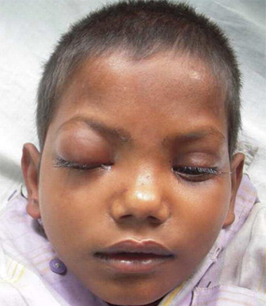Summary
Definition
History and exam
Key diagnostic factors
- presence of risk factors
- rapid onset of signs and symptoms (acute septic CST)
- headache
- fever
- peri-orbital oedema
- chemosis and proptosis
- lateral gaze palsy
- ophthalmoplegia
- profound sepsis (acute septic CST)
Other diagnostic factors
- ptosis and mydriasis
- papilloedema and/or retinal-vein dilatation
- decreased corneal reflex
- hypo- or hyper-aesthesia in the distribution of the ophthalmic and maxillary nerves
- mental state changes (e.g., confusion, drowsiness, coma)
- clinically detectable primary infection site
- meningismus (nuchal rigidity, photophobia, and headache)
- positive Kernig's or Brudzinski's signs
- seizures
- loss of visual acuity
Risk factors
- recent history of acute sinusitis
- history of facial infections
- history of peri-orbital infection
- history of otitis media, mastoiditis, or petrositis
- history of dental or oral infection
- history of sepsis
- immunosuppression
- genetic prothrombotic condition
- acquired and other prothrombotic states
- history of head and neck trauma
- use of oral contraceptives
- pregnant or postpartum
- history of malignancy
- history of recent head or neck surgery
- vascular abnormalities
- ulcerative colitis
- volume depletion
- heroin overdose
Diagnostic investigations
1st investigations to order
- FBC
- contrast-enhanced high-resolution CT of head
- contrast-enhanced MRI of head
- blood culture
- microscopy and culture of suppurative fluid or tissue from primary infective source
- antiphospholid and anticardiolipin antibodies
- protein S and protein C
- antithrombin III
- factor V Leiden
- haemoglobin electrophoresis
Treatment algorithm
Contributors
Authors
Jayant Pinto, MD
Associate Professor of Surgery
Section of Otolaryngology-Head and Neck Surgery
University of Chicago
IL
Disclosures
JP serves as a speaker and advisor to Optinose and Stallergenes. JP is a member of the advisory board for Genentech and ALK. JP has received grants from the National Institutes of Health.
Mohamad R. Chaaban, MD, MSCR, MBA
Associate Professor
Cleveland Clinic
Lerner College of Medicine at Case Western Reserve University
Cleveland
OH
Disclosures
MC is a member of the advisory board of Optinose.
Peer reviewers
David Rowed, MD
Division of Neurosurgery
University of Toronto
Toronto
Ontario
Canada
Disclosures
DR declares that he has no competing interests.
Louis R. Caplan, MD
Lecturer in Neurology
Hospital Chief
Cerebrovascular/Stroke Division
Beth Israel Deaconess Medical Center
Division of Cerebrovascular/Stroke
Boston
MA
Disclosures
LRC declares that he has no competing interests.
Sorabh Khandelwal, MD
Clinical Associate Professor of Emergency Medicine
Ohio State University
Columbus
OH
Disclosures
SK declares that he has no competing interests.
Use of this content is subject to our disclaimer
